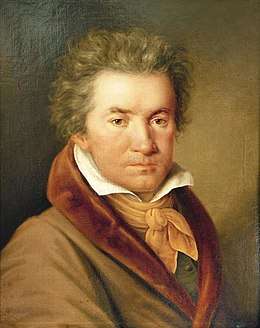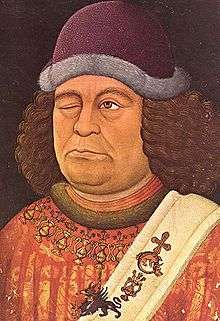Lied
The lied (/liːd, liːt/, plural lieder /ˈliːdər/ (Collins English Dictionary n.d.; Random House Unabridged Dictionary 1997; American Heritage Dictionary 2018); German pronunciation: [liːt], plural [ˈliːdɐ], German for "song") is a term in the German vernacular to describe setting poetry to classical music to create a piece of polyphonic music (Böker-Heil, et al. 2011). The term is used for songs from the late fourteenth or early fifteenth centuries or even to refer to Minnesang from as early as the 12th and 13th centuries (Encyclopædia Britannica 1998). It later came especially to refer to settings of Romantic poetry during the late eighteenth and nineteenth centuries, and into the early twentieth century. Examples include settings by Ludwig van Beethoven, Franz Schubert, Robert Schumann, Johannes Brahms, Hugo Wolf or Richard Strauss. Among English speakers, however, "lied" is often used interchangeably with "art song" to encompass works that the tradition has inspired in other languages. The poems that have been made into lieder often center on pastoral themes or themes of romantic love (Anon. 2014).


Examples
Typically, lieder are arranged for a single singer and piano; lieder with orchestral accompaniment being a later development. Some of the most famous examples of lieder are Schubert's Der Tod und das Mädchen ("Death and the Maiden"), Gretchen am Spinnrade, and Der Doppelgänger. Sometimes, lieder are composed in a song cycle (German Liederzyklus or Liederkreis), a series of songs (generally three or more) tied by a single narrative or theme, such as Schubert's Die schöne Müllerin and Winterreise, or Robert Schumann's Frauen-Liebe und Leben and Dichterliebe. Schubert and Schumann are most closely associated with this genre, mainly developed in the Romantic era (Deaville 2004, 143; Thyme 2005, 90).
History
For German speakers, the term "Lied" has a long history ranging from twelfth-century troubadour songs (Minnesang) via folk songs (Volkslieder) and church hymns (Kirchenlieder) to twentieth-century workers' songs (Arbeiterlieder) or protest songs (Kabarettlieder, Protestlieder).
The German word Lied for "song" (cognate with the English dialectal leed) first came into general use in German during the early fifteenth century, largely displacing the earlier word gesang. The poet and composer Oswald von Wolkenstein is sometimes claimed to be the creator of the lied because of his innovations in combining words and music (Orrey and Warrack 2002). The late-fourteenth-century composer known as the Monk of Salzburg wrote six two-part lieder which are older still, but Oswald's songs (about half of which actually borrow their music from other composers) far surpass the Monk of Salzburg in both number (about 120 lieder) and quality (Böker-Heil, et al. 2011).
In Germany, the great age of song came in the nineteenth century. German and Austrian composers had written music for voice with keyboard before this time, but it was with the flowering of German literature in the Classical and Romantic eras that composers found inspiration in poetry that sparked the genre known as the lied. The beginnings of this tradition are seen in the songs of Haydn, Mozart and Beethoven, but it was with Schubert that a new balance was found between words and music, a new expression of the sense of the words in and through the music. Schubert wrote over 600 songs, some of them in sequences or song cycles that relate an adventure of the soul rather than the body. The tradition was continued by Schumann, Brahms, and Hugo Wolf, and on into the 20th century by Strauss, Mahler, and Pfitzner. Composers of atonal music, such as Arnold Schoenberg (Gramit 2004, 311), Alban Berg and Anton Webern, also composed lieder.
Other national traditions
The lied tradition is closely linked with the German language, but there are parallels elsewhere, notably in France, with the mélodies of such composers as Berlioz, Fauré, Debussy, and Francis Poulenc, and in Russia, with the songs of Mussorgsky and Rachmaninoff in particular. England too had a flowering of song, more closely associated, however, with folk songs than with art songs, as represented by Vaughan Williams, Benjamin Britten, Ivor Gurney, and Gerald Finzi.
References
- American Heritage Dictionary, Editors of. 2018. "Lied". Random House Unabridged Dictionary. New York: Houghton Mifflin Harcourt; online at ahdictionary.com (accessed 30 November 2018).
- Anon. 2014. "Lieder". GCSE Bitesize: BBC Schools (archived 2014; accessed 30 November 2018).
- Böker-Heil, Norbert, David Fallows, John H. Baron, James Parsons, Eric Sams, Graham Johnson, and Paul Griffiths (2011). "Lied". Grove Music Online, edited by Deane L. Root. Oxford Music Online (26 October). Oxford University Press, accessed December 26, 2016.
- Collins English Dictionary, Editors of. n.d. "Lied". Collins English Dictionary online (accessed 30 November 2018).
- Deaville, James (2004). "A Multitude of Voices: The Lied at Mid Century". In The Cambridge Companion to the Lied, edited by James Parsons, 142–67. Cambridge and New York: Cambridge University Press. ISBN 978-0-521-80471-4.
- Encyclopædia Britannica, Editors of The. 1998. "Lied: German Song". Encyclopædia Britannica online (accessed 30 November 2018).
- Gramit, David (2004). "The Circulation of the Lied: The Double Life of an Art Form". In The Cambridge Companion to the Lied, edited by James Parsons, 301–14. Cambridge and New York: Cambridge University Press. ISBN 978-0-521-80471-4.
- Orrey, Leslie, and John Warrack (2002). "Lied". The Oxford Companion to Music, edited by Alison Latham. Oxford and New York: Oxford University Press. ISBN 978-0-19-866212-9.
- Random House Unabridged Dictionary, Editors of. 1997. "Lied". Random House Unabridged Dictionary. New York: Random House, Inc., reprinted on Infoplease. (accessed 30 November 2018).
- Thyme, Jürgen. 2005. "Schubert’s Strategies in Setting Free Verse". In Word and Music Studies: Essays on Music and the Spoken Word and on Surveying the Field: Essays from the Fourth International Conference in Word and Music Studies, Berlin, 2003, edited by Suzanne M. Lodato and David Francis Urrows, 81–102. Word and Music Studies 7. Amsterdam and New York: Editions Rodopi. ISBN 978-90-420-1897-6.
Further reading
- Hallmark, Rufus (ed.) (1996). German Lieder in the Nineteenth Century. New York: Schirmer Books. ISBN 978-0-02-870845-4.CS1 maint: extra text: authors list (link)
- Parsons, James (2004). The Cambridge Companion to the Lied. Cambridge Companions to Music. Cambridge: Cambridge University Press. ISBN 978-0-521-80027-3.
- Lieder line by line
External links
| Look up lied in Wiktionary, the free dictionary. |
- The LiederNet Archive, texts and translations
- The Lieder Sound Archive
- The OpenScore Lieder Corpus, public domain transcriptions to play or download
- The Art Song Project
- Aubrey Pankey, an African-American lieder singer
